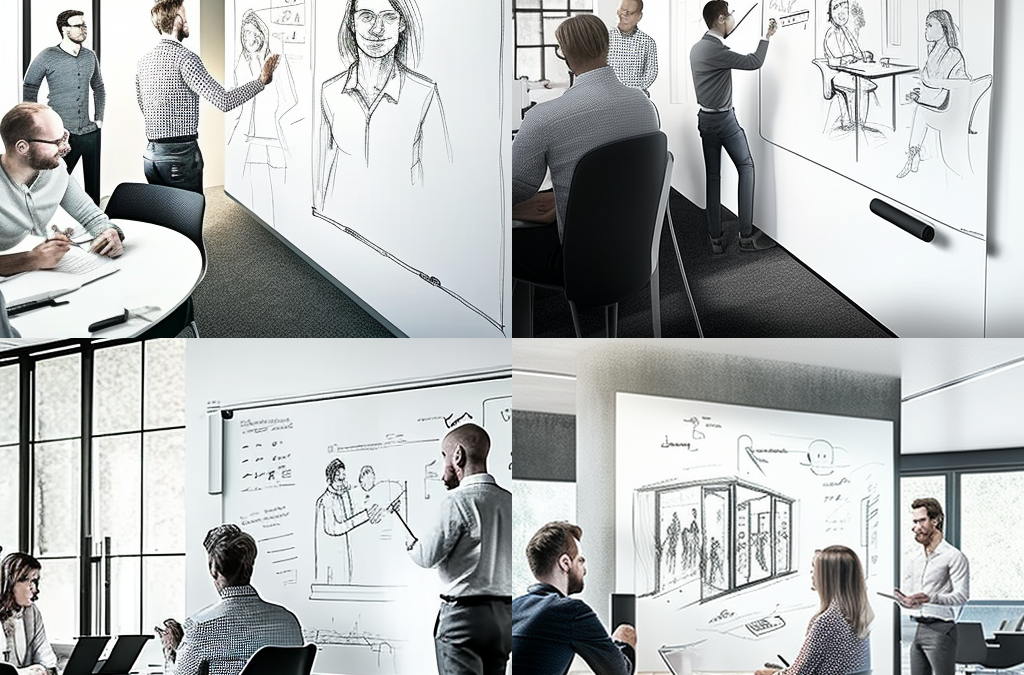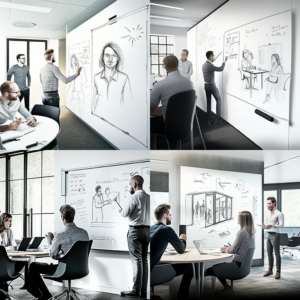How a Dry Erase Wall is Revolutionizing Idea Generation
In a world driven by creativity and innovation, the power of visual thinking has gained significant recognition. The ability to visually map ideas, develop concepts, and engage in visual brainstorming has become crucial for effective idea generation. This article explores the growing popularity of visual thinking and its connection to the revolutionary tool of a dry erase wall. Discover how utilizing it for mind mapping, concept development, and visual brainstorming can unleash your creativity, foster innovation, and transform how ideas are generated.
Unleashing Creativity with Mind Mapping
Mind mapping is a powerful technique to help individuals gain clarity and structure around their thoughts to generate ideas, problem-solve, and connect various concepts. Using a large dry erase wall as a canvas for creating mind maps provides an unrestricted environment where people can freely visualize and explore new possibilities creatively. This type of free-flowing brainstorming helps to spark innovative thinking and allows for expansive exploration as ideas unfold. By allowing users to identify relationships between disparate information, mind mapping serves an invaluable purpose in planning and provides an opportunity to see the bigger picture.
Using this tool not only facilitates a more thorough understanding of core concepts but also offers valuable insight by uncovering potential opportunities or solutions that may have gone unnoticed beforehand. Overall, mind mapping on a dry erase painted wall is a highly effective collaboration tool that will assist individuals in better organizing complex material, discovering meaningful patterns, and strengthening their capacity for creative problem-solving.
1. Creating an Inspiring Visual Landscape:
- The expansive surface of a dry erase wall offers ample room for free-flowing creativity.
- Users can experiment with different colors, shapes, and fonts to improve visual appeal.
- By immersing oneself in an atmosphere of intrigue and fascination, the mind is prompted to explore avenues of originality, fostering creative thought and amplified ingenuity.
Example: Imagine a marketing team brainstorming new advertising campaign ideas. The group gathers around a dry erase wall, where they create a mind map using vibrant colors, connecting various concepts and themes. This visually captivating landscape sparks their creativity and leads to the generation of unique and impactful ideas.
2. Stimulating Associative Thinking
- A dry erase wall enables individuals to create associations between related concepts.
- Users can connect ideas using lines, arrows, and shapes, establishing relationships that enhance understanding and spark new connections.
- The visual nature of mind mapping on such wall enhances associative thinking, leading to novel and unique ideas.
Example: In a design studio, a team uses a dry erase wall to map out the user journey for a new website. They connect different touchpoints, user actions, and emotions using visual elements. This visual representation stimulates associative thinking, allowing them to uncover new insights and design user-centric experiences.
Developing Concepts through Visual Exploration
Visual exploration is an invaluable component of the ideation process when it comes to developing concepts. By visually exploring ideas, teams can create and evaluate potential solutions more efficiently and effectively. One of the most effective tools for visual exploration is a dry erase wall, which allows for dynamic and interactive sketching, diagramming, and visualization of ideas.
Moreover, dry erase walls provide flexibility in brainstorming sessions as collaborators can draw on whiteboards without worrying about making mistakes or being limited by traditional writing materials. Moreover, they enable quick editing and revising of ideas as changes can be made instantly with a simple swipe of an eraser. Additionally, participants can visualize relationships between various concepts better due to the spaciousness of these surfaces. Ultimately, dry erase painted walls offer a dependable solution for teams looking to explore ideas through creative visual exploration.
1. Sketching and Doodling:
- The vast surface of a dry erase painted wall encourages freehand sketching and doodling.
- Individuals can visualize concepts, ideas, and relationships quickly through simple drawings and diagrams.
- Visually representing thoughts and ideas fosters a deeper understanding and generates new perspectives.
Example: A group of architects uses a dry erase wall to brainstorm design ideas for a new building. They sketch different architectural elements, experiment with floor plans, and explore innovative structural concepts. This visual exploration helps them refine their ideas and visualize the building’s aesthetics.
2. Iterative Concept Development:
- The erasable nature of a dry erase wall allows for quick modifications and iterations.
- Users can refine and enhance their concepts by erasing and redrawing, leading to continuous improvement and innovation.
- Seeing ideas evolve and transform visually enhances the creative process, producing more refined and well-developed concepts.
Example: A product development team utilizes a dry erase painted wall to ideate and iterate on a new product design. They sketch the initial concept, gather feedback, and make adjustments directly on the wall. This iterative process allows them to refine the product’s features and create a design that meets the needs of their target audience.
Visual Brainstorming for Collaborative Innovation
Traditional brainstorming sessions typically involve using sticky notes, whiteboards, or flip charts; however, a dry erase wall provides an enhanced platform for idea generation. By providing a larger and more interactive canvas, it encourages high levels of engagement from all participants. Thus, this allows for exploring multiple lines of thought and facilitates conversation, resulting in more productive and creative brainstorming sessions.
Furthermore, unlike traditional tools such as sticky notes that can be easily misplaced or overlooked, the it lets participants view all ideas in one place. Through this collaborative process, individuals can better visualize the concepts discussed and better understand how they might interconnect. The ability to quickly move and rearrange items on the board further promotes creativity by inspiring unique solutions often missed in more static settings. Therefore, a dry erase painted wall offers an ideal environment for those seeking to undertake complex problem-solving tasks with maximum efficiency.
1. Engaging Collaboration:
- A dry erase wall encourages active participation and collaboration among team members.
- Individuals can contribute ideas, sketches, and annotations directly on the wall, creating a visually engaging and dynamic brainstorming session.
- The inclusive nature of visual brainstorming on dry erase walls fosters a sense of ownership and collective intelligence, leading to more innovative ideas.
Example: A design agency conducts a visual brainstorming session for a client project. Team members gather around a dry erase wall, contributing their ideas and sketches. They build upon each other’s concepts, combining their expertise to generate a comprehensive and visually compelling solution for the client.
2. Capturing and Retaining Ideas:
- Dry erase walls allow for the visualization and organization of ideas in real time.
- As ideas emerge during brainstorming sessions, they can be immediately captured on the wall, ensuring they are preserved and remembered.
- The visual nature of the wall makes it easy to review and revisit ideas, fostering a collaborative environment where ideas can be built upon and refined.
Example: An innovation team in a tech company uses a dry erase painted wall to brainstorm ideas for a new product feature. As ideas flow, they capture them on the wall, grouping related concepts and adding annotations. This visual capture ensures that no ideas are overlooked and allows the team to quickly revisit and refine them during the development process.
Conclusion
Visual thinking has revolutionized how we generate ideas, and a dry erase wall holds a prominent role in this transformation. By utilizing mind mapping, concept development, and visual brainstorming techniques, you can unlock the full potential of visual thinking and cultivate more creative ideas that are not limited by traditional thought patterns.
By embracing the power of a dry erase painted wall, you can embark on an inspiring journey of limitless creativity and foster an environment where innovation is encouraged, and creativity is celebrated. Elevate your idea-generation process, embrace visual thinking, and witness its remarkable impact on your productivity and personal growth.



Recent Comments